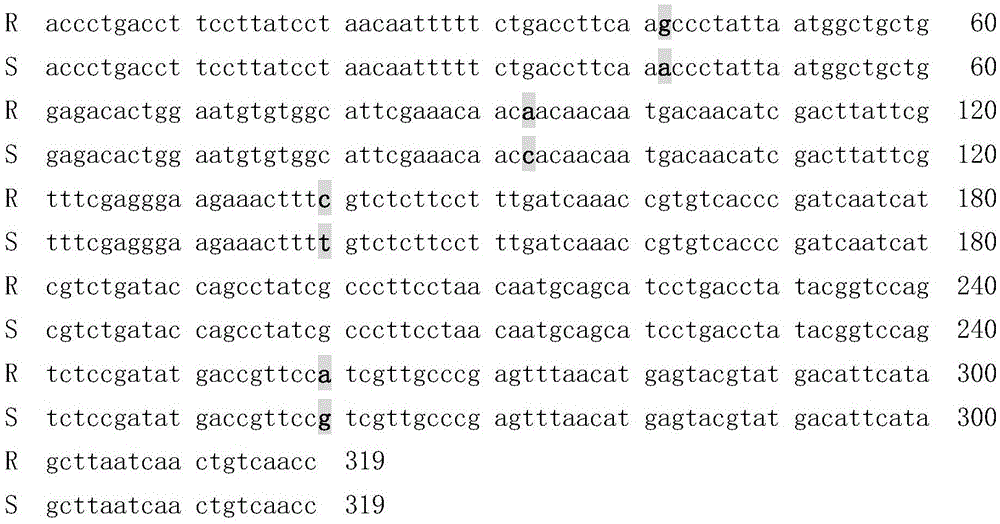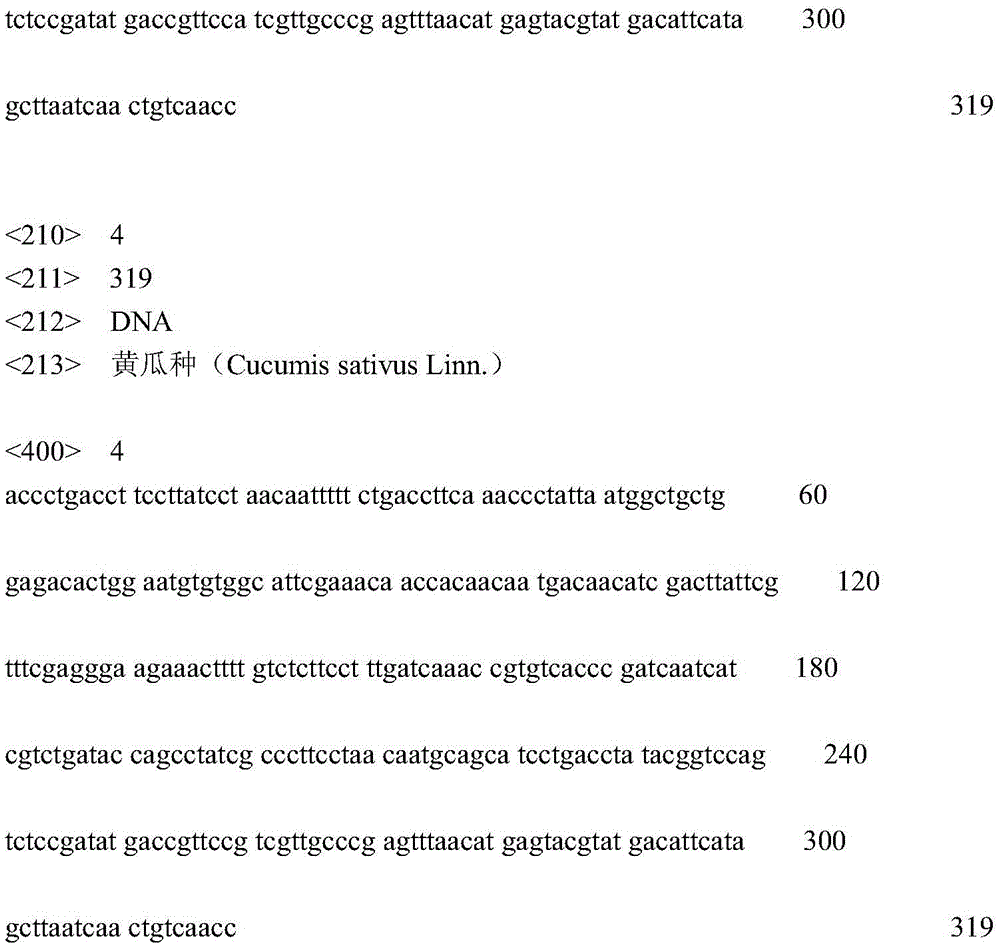SNP (single-nucleotide polymorphism) marker method for detecting cucumber Corynespora-cassiicola-resistant site
A technology of Corynesporium leaf spot and cucumber, which is applied in the field of SNP markers and identification of cucumber Corynesporium leaf spot resistance, can solve the problems that there are no relevant reports in the research of cucumber Corynesporium leaf spot assisted breeding, and achieve the method Simple, efficient and reliable results
- Summary
- Abstract
- Description
- Claims
- Application Information
AI Technical Summary
Problems solved by technology
Method used
Image
Examples
Embodiment 1
[0019] The primers used for detecting the resistance of cucumber to Corynesporium leaf spot consist of the forward primer shown in SEQIDNo.1 and the reverse primer shown in SEQIDNo.2.
[0020] Forward primer F: 5'-accctgaccttccttatc-3' (SEQ ID No.1)
[0021] Reverse primer R: 5'-ggttgacagttgattaagc-3' (SEQ ID No.2)
[0022] The above primers are used to detect four SNP loci associated with resistance to Corynespora leaf spot of cucumber at bases 9718701, 9718752, 9718799 and 9718919 of the cucumber genome sequence Csa6M138620.1. The resistance to leaf spot disease was well typed, that is, the base forms at 9718701, 9718752, 9718799 and 9718919 were detected to express the differences in the resistance and susceptibility of cucumber to Corynespora leaf spot disease. The four SNP markers are located on the sixth chromosome of cucumber.
Embodiment 2
[0024] The SNP marker method for detecting the resistance locus of cucumber Corynesporium leaf spot, comprising the steps:
[0025] (1) extracting the cucumber genomic DNA of the tested sample;
[0026] (2) Using the cucumber genomic DNA as a template, and using the nucleotide sequences described in SEQIDNo.1 and SEQIDNo.2 as upstream and downstream primers, carry out PCR amplification, and put into the special thin-walled tube for PCR amplification: the Described cucumber genomic DNA 20ng, the nucleotide sequence 25ng described in SEQIDNo1 in the sequence listing, the nucleotide sequence 25ng described in SEQIDNo2 in the sequence listing, dNTP0.20mM, Mg 2+ 1.5mM, 1 times PCR buffer, 1.0 units of TaqDNA polymerase, add sterile double distilled water to 20μl, put the special thin-walled tube for PCR amplification into the PCR instrument for amplification, the amplification conditions are: 94°C pre- Denaturation for 180 seconds, denaturation at 94°C for 60 seconds, annealing at...
Embodiment 3
[0032] Identification of Cucumber Germplasm Resources Corynesporium Leaf Spot Resistance
[0033] Cucumber germplasm resources XL6-1-2, 09L4, Q6, LX-11-1, P62-1-1, D507-1-1, Q5, JY118, etc. were selected from the breeding room of Tianjin Kerun Cucumber Research Institute. The method in Example 2 was used to operate: after testing, the amplification products of XL6-1-2, 09L4, Q6, LX-11-1, and Q5 all had the nucleotide sequence described in SEQIDNo. Leaf spot disease resources; P62-1-1, D507-1-1 amplification products appear the nucleotide sequence described in SEQIDNo.4, which is the resource of Corynesporium leaf spot disease; JY118 amplification products appear SEQIDNo.3 and SEQIDNo. . The nucleotide sequence described in 4 is the resource of impoverished Corynesporium leaf spot disease.
[0034]
[0035]
PUM
 Login to View More
Login to View More Abstract
Description
Claims
Application Information
 Login to View More
Login to View More - R&D
- Intellectual Property
- Life Sciences
- Materials
- Tech Scout
- Unparalleled Data Quality
- Higher Quality Content
- 60% Fewer Hallucinations
Browse by: Latest US Patents, China's latest patents, Technical Efficacy Thesaurus, Application Domain, Technology Topic, Popular Technical Reports.
© 2025 PatSnap. All rights reserved.Legal|Privacy policy|Modern Slavery Act Transparency Statement|Sitemap|About US| Contact US: help@patsnap.com



